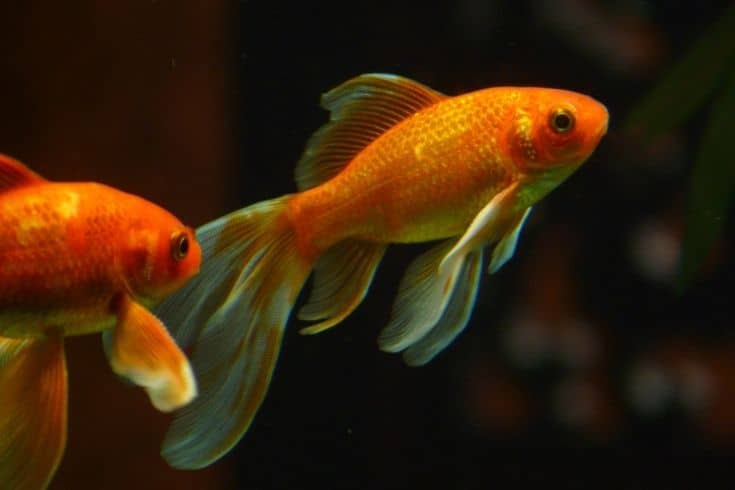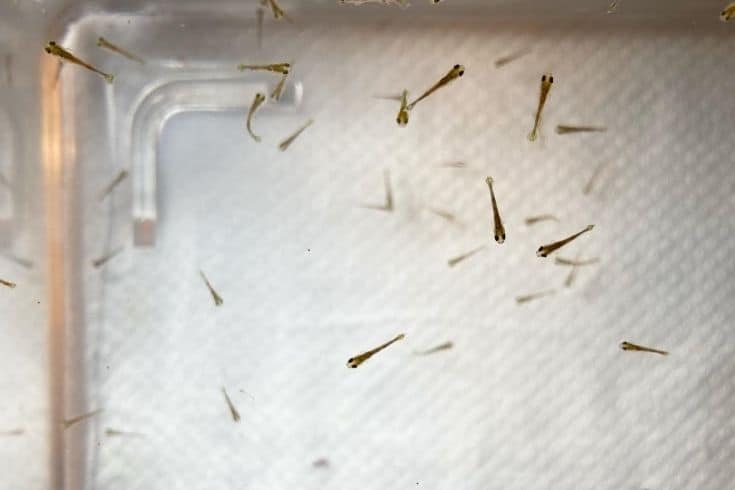Goldfish are a very popular type of pet fish and for a good reason! They’re beautiful to look at, relatively easy to care for, and can live for a long time. If you’re thinking about getting goldfish, you may be wondering how they mate and reproduce.
Keep reading to learn everything you need to know about goldfish reproduction!
At What Age Do Goldfish Start Mating?
Goldfish owners who are interested in breeding their pets often wonder how to select an ideal adult goldfish pair. You should wait until your goldfish is about one year old before mating them, so they have time to mature fully first. This will give you a better chance of producing strong offspring that can withstand the rigors of life in captivity.
When you’re ready to select a pair of goldfish for breeding, it’s best to choose adult fish that are similar in size and shape. You’ll also want to avoid the interbreeding of genetically related goldfish, as this can lead to birth defects such as deformities, blindness, and other health problems. They may also display a higher rate of infection and stress.
Generally speaking, goldfish hit their prime reproductive years between three and five years of age. After this point, their fertility will start to decline. Common goldfish are known to live for about 10 years, but you should expect their fertility to decline sooner than that. Fancy goldfish varieties can live for as long as 20 years, but their fertility will generally decline before then.
Goldfish Mating Season

The mating season for goldfish typically begins in the springtime when the water temperatures start to rise. Generally, we’re looking at temperatures between 60 and 70 degrees Fahrenheit. The males will start to develop white spots on their heads and fins, which is a sign that they’re ready to mate. These spots are known as breeding tubercles, and they help the male to grip the female during mating.
The female goldfish will also start to develop white spots on her body, but these are usually much smaller than the ones on the males. The female’s belly will also swell as she starts to produce eggs. You may also notice that the females start to chase the males around, and that the males start to chase the females. This is all part of the goldfish mating dance!
How Do You Encourage Goldfish To Mate?
A key part of the natural goldfish mating process is the spawning ritual. This is when the female goldfish releases her eggs into the water, and the male goldfish fertilizes them. The best way to encourage your pet goldfish to mate is to decorate your goldfish tanks to mimic their natural breeding environment as much as possible. Here are some factors to take into account:
Tank Temperature
As mentioned earlier, goldfish parents mate when the water temperature is between 60 and 70 degrees Fahrenheit. You can use a aquarium heater to raise the water temperature if necessary. Remember to invest in a good, quality aquarium heater that is strong enough to stabilize the water temperature.

Additionally, you should also invest in a reliable thermometer to monitor the water temperature. This will allow you to adjust it if necessary, and make sure that your goldfish mate at the ideal time each year.
Tank Water Parameters
One of the key aspects of creating an ideal breeding condition is ensuring that water parameters are up to par. The water should be clean and well-oxygenated. You can achieve this by performing regular water changes and using a good filter system. A power filter is a good option, as it will help to keep the water moving and ensure that it is properly aerated.
The lack of these conditions will not only disincentivise your pair of goldfish from breeding, but may also cause sluggish behavior and poor health in your fish. In general, goldfish are some of the most hardy freshwater fish, but they are still susceptible to poor water conditions.
Ideal Male-to-Female Ratio
To encourage breeding, you should also make sure that the male-to-female ratio in your tank is about 2:1. This will give the males enough competition to be motivated to mate with the females. It will also give them sufficient space to chase the females around.
If you have too few males, they may not feel as motivated to mate and they’ll be spaced out too far apart to properly perform their mating dance. Also, if there are too many males, they may start fighting rather than mating with the females.
Tank Setup
When you’re planning to breed goldfish in captivity, you must create a setup that mimics their natural environment as closely as possible. This will encourage them to mate more readily and help ensure their offspring’s survival. Try to choose goldfish-friendly plants that closely resemble the type of vegetation and terrain that you would find in a natural goldfish habitat.
Some good options include:
- Water sprite
- Anacharis
- Cabomba
- Hornwort
- Java fern
- Java moss
- Wisteria
In addition to plants, you can also use spawning mats, ceramic caves, and other similar decorations to give your goldfish a place to hide and lay their eggs. These decorations also provide shelter for the fry once they hatch.
How Do Goldfish Mate
After getting your tank and goldfish ready, your next step will encourage your goldfish mates to start the mating process. The mating process unfolds in the following manner:
Spawning
When the goldfish are ready to mate, a ritual called “spawning” will take place where the male chases the female fish and gently nudges her belly with his nose. He may even nip at her fins playfully as part of this process. This is all part of his way of getting her to release her eggs!
Some goldfish enthusiasts may confuse this behavior for aggression, but it’s really just the goldfish’s way of saying “Let’s mate!” The difference between aggressive behavior and the goldfish spawning process is that the latter is much more gentle and playfully done.
Fertilization
After the goldfish have spawned, it’s time for fertilization. The female will release her eggs, and then the male will release his sperm at the same time to fertilize them. These eggs are sticky and will adhere to plants or other objects in the tank. The male goldfish will then release his sperm (or milt) over the eggs to fertilize them.
To keep the eggs safe, removing any plants or other objects from the tank before spawning begins is a good idea. This way, you can control where the eggs are laid and make sure they’re in a safe place. You may also want to remove the male goldfish after spawning so he doesn’t eat the eggs!
Another thing you can do is move the fertilized eggs to a separate fry tank. This is often done in commercial goldfish hatcheries housing outdoor goldfish to avoid the risk of the eggs being eaten. It’s important to note that goldfish can store sperm in their bodies, which means that multiple males can fertilize a single female. This is called “superfetation.”
Hatching and Development
Once the eggs have been fertilized, it will take about 4-7 days to hatch. The incubation period for goldfish eggs varies depending on the temperature – the warmer the water, the faster they’ll hatch. When the eggs hatch, goldfish fry remain attached to their egg sacs for another few days. After they’ve absorbed the egg sac, they’ll start to swim around and feed on microscopic organisms.

Once the eggs have hatched, it will take anywhere from 3-7 weeks for the baby goldfish to fully develop. In general, you can expect them to grow about 1 inch per week until they reach their adult size. Of course, this growth rate will depend on the quality of care they’re receiving and the food they’re eating.
We recommend providing a good diet of high-quality fish food, such as brine shrimps, to get them off to a great start in life. Goldfish fry pellets or specially formulated goldfish flakes will also provide your goldfish babies with their nutrition.
Maturing
As the goldfish grow and mature, you may notice some behavioral changes in their mating behavior. For instance, it’s not uncommon for adult male goldfish to exhibit aggressive behaviors towards other males or even females during the breeding season.
It’s important to be patient with your goldfish and provide a healthy, supportive environment so they can thrive. With proper care, you’ll have a happy, healthy population of grown-up goldfish in no time!
Keeping Goldfish Fry Safe
One of the main goals of breeding goldfish is to produce a healthy batch of goldfish babies that can be raised to adulthood. However, this is not always an easy task. Mature goldfish are susceptible to a number of diseases that can be passed on to their offspring. Signs of disease in goldfish fry can include lethargy, discoloration, sores or abrasions, or even a change in behavior.
Fortunately, there are things you can do to protect the health of your goldfish babies and help them grow big and strong. For starters, make sure that every generation of baby goldfish is raised in a clean, healthy environment. This means giving them plenty of space to swim, providing good-quality food, and ensuring the water is clean.
Another thing you can do is quarantine the goldfish fry and watch for signs of disease or any other problems. If you notice anything unusual, you may need to remove the goldfish from its original habitat and keep it in a separate tank. This may seem tedious, but it’s important to take these precautions to ensure that you raise robust goldfish.
The Takeaway
So there you have it – a complete guide to the fascinating world of goldfish mating! Whether you’re an experienced fishkeeper or just starting out, it’s always good to know more about your pets. Understanding the way goldfish mate can help you provide them with better care and give you a greater appreciation for these unique creatures.
If you’re looking for other resources on keeping goldfish, check out our blog! We have plenty of other articles and posts on everything from caring for goldfish fry to goldfish tank setup. Thanks for reading!
